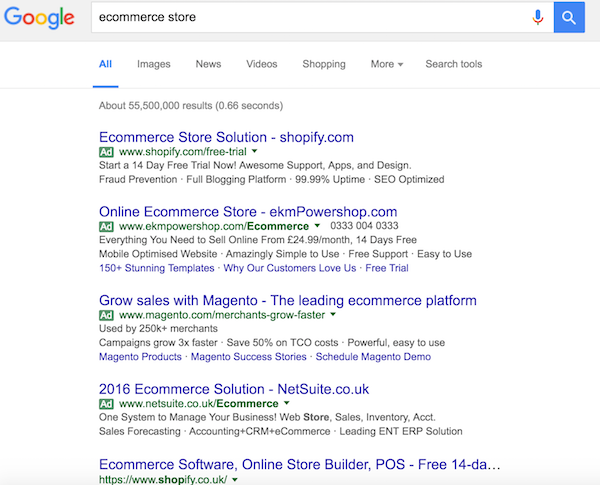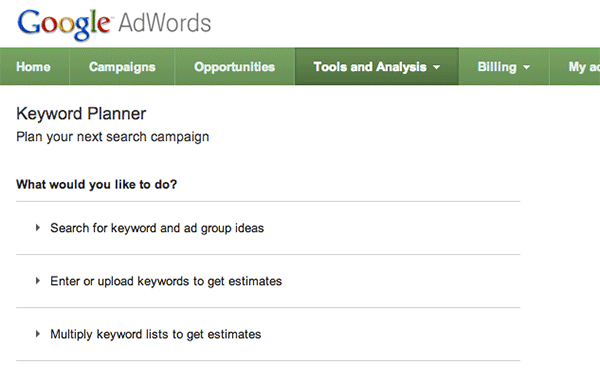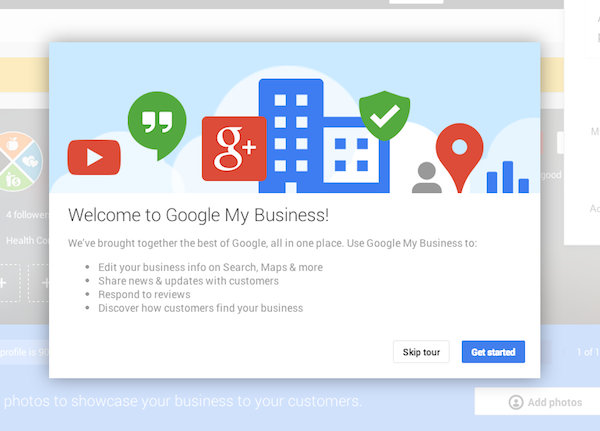Budget constraints put local businesses in a tough position when it comes to marketing. The situation becomes even worse when it comes to local on-page SEO, as it’s difficult to determine ROI beforehand.
This was less of a problem two or three years ago, when cheap/predictable local SEO was possible – even if such spammy tactics inevitably posed a threat to brand reputation.
But times have changed. How Google works has changed.
People such as Neil Patel are saying “content marketing is the new SEO.” If the mainstream SEO opinion is to be believed, without a content marketing strategy in place you might as well forget about Google doing you any favours.
Except, that’s not really true. There’s so much more to do in SEO than content marketing.
What follows are many things that you can do as a local business to make the most out of local search.
1. Pick an alternative to content
Before we dive into some SEO techniques that can help you get that much needed search traffic, we need to address this question:
“Why would people link to/share/talk about my site?”
Everybody’s answer these days seems to be “compelling content.” We’re arguing that this isn’t a necessity by any means. Still, Google is obviously looking for editorial links, and a website with just a company backstory, a sales pitch, and driving directions isn’t going to earn many of those.
So what do you do instead of content?
You look at the most successful sites on the web, and you realize that most of them aren’t really content sites either. They’re:
- Utilities
- Communities
- Games
So the goal isn’t really to create ‘compelling content’. It’s to give people something useful, entertaining, interactive, or all of the above.

What kinds of problems do your target customers have to deal with? Is there a way you could build an application that would help them solve that problem?
True, the resources involved in creating a web utility are certainly more extensive than the resources involved in creating a single blog post. But the amount of resources it takes to build a blog into something that attracts and retains business is often more than the resources necessary to do the same with an online tool.
Do you have a loyal customer base? If so, would they be interested in joining an online community devoted to their needs, or the inside jokes of a specific subculture?
If you’re better at getting people together and getting them to talk about things than you are at creating ‘content’, building an online community like a forum might come easier for you than running a blog.
Creating interactions is more important than creating content. You don’t need “great content” to earn editorial links. You just have to offer something of value to the web.
2. Skip the exact match domain name
SEO pros know this one inside and out by now. If you’re hoping your local business site is going to rank because your domain name matches the keyword people will be searching for, it doesn’t work that way anymore. In fact, Google had an update specifically to fight this issue.
Using a good brand name for your domain is smart for more traditional marketing reasons, but it actually offers SEO benefits as well.
Here’s why.
Google analyzes search behavior as a way to determine which sites are authoritative. With millions of people searching for “Amazon” every day, and clicking on the link to Amazon.com, Google knows these people aren’t looking for info about a river in South America.
If people search for a product name along with the word Amazon, you can bet a huge portion of the search results will be product listings on Amazon.com.
But what happens when you search for ‘ecommerce store’? Well, you get search results for places like Shopify.

Here’s the thing. There are plenty of sites with the name ‘ecommerce’ in the URL. Those sites aren’t turning up on the front page of Google.
If you name your site after an already popular search phrase, Google will never be able to tell whether additional searches for the phrase are attributed to your business, or to a growing general interest in that phrase.
If, on the other hand, your domain name is uniquely branded, Google can attribute those searches to an interest in your brand, and it will likely give you a boost in the search results for several other queries as well, just like Shopify did in our little experiment.
You want to be Nike.com, not RunningShoes.biz.
On a related note, it’s a bad idea to use your city name without the domain. Not only does it take users more time to type in the address, it also creates an obstacle to future growth if you ever decide to sell online to a global audience, or expand into new locations.
3. Build an intuitive, responsive website with rich UI and UX
The average local website offers a sub-par user experience. This is because most local businesses fail to properly anticipate what people are looking for when they visit.
Here’s what I mean. Take a look at most local restaurant’s websites. Here’s what you’ll often see:
- A slideshow of happy people eating food, because slideshows are so chic.
- A long-winded history of the restaurant and it’s values.
- Upcoming events.
- Shameless calls to action on social networks.
- A photo gallery.
- Irritating Flash, PDFs, etc. that are inconvenient to work with.
And all of this is usually cluttered and above the fold. The user often gets “banner blindness” on the entire homepage, because there are so many competing messages and most of them are completely out of sync with the user’s intentions, which come down to:
- What kind of food is here?
- How much does it cost?
- How do I get there?
All of this is made worse by the fact that most of these sites look terrible on mobile phones, even though finding local businesses is one of the main things people use mobile internet for.
UI and UX are important for SEO. Here are a few of the reasons why:
- Responsive design is a must. You need the site to look good, and be easy to use, on mobile devices, not just because mobile is set to overtake desktop, but because people often look for local businesses while they are on the go.
- Split test your landing pages, starting with core concepts. You can measure the effectiveness of your landing pages by offering a different coupon code for each.
- Run usability tests to determine what users want to use your site for, and how to make it easiest for them to do it.
- Understand consumer psychology, and build it into the site.
All of these things are necessary in order to make the most of your site’s presence in the search results. People who fail to find what they are looking for quickly and easily will simply look elsewhere, making your presence in Google meaningless.
Here’s what you can usually expect users to be looking for:
- Prices and products.
- An address and phone number, plainly visible.
- A quick contact form.
Other things they might be looking for, but that should take up less visual space on the landing page, include:
- Your blog, tool, community, or other primary source of “linkbait”.
- Video testimonials.
- Unfiltered consumer reviews (You can and should embed Google+ reviews on your site).
- Trust-building icons, memberships, certifications, “featured in” mentions, etc.
Finally, the lowest priority things will be the business story and history, a photo gallery, events, and so on. It’s not that these are unimportant, it’s that they are not the primary things your users are looking for, and they shouldn’t be allowed to obstruct their flow.
Usability and design are also the first things people notice when they visit a site. Ninety-four percent of users point to design-related issues when they conclude that a site isn’t trustworthy.
And, of course, Google isn’t interested in ranking sites that people feel aren’t trustworthy.
4. Optimize the most important on-page factors
On-page SEO is still very important, and this is probably even truer for local businesses than for general websites.
For starters, you’ll need to decide on which keywords to target. While it’s true that “long tail” keywords are becoming more important, and that Hummingbird is allowing Google to interpret queries better than before, keyword targeting is still a very important part of SEO.
While Google killed the old AdWords Keyword tool, the new Keyword Planner is still a good way to discover keywords. Moz has a great guide explaining how you can use it to find keywords for local search.

The most important thing to understand about keyword research in the wake of Hummingbird is this: only the highest traffic keywords matter.
Here’s what I mean by this: you can’t find a niche by targeting a more obscure phrase if it means the same thing as a more common phrase. Hummingbird simply replaces the low traffic query with the higher traffic query.
It used to be the case that if the front page of Google didn’t list any pages with the exact keyword phrase, you were basically set. This isn’t the case anymore.
With that in mind, here are a few on-page things you’ll want to try to optimize (but never to the detriment of user experience):
- Title: Use the K.I.S.S. (keep it simple, stupid) principle here. Don’t try to jam it full of keywords. Try to use the city name and keyword (or a variant of the keyword) if possible. However, it’s important to keep CRO in mind, and choose a title that will entice people to click through.
- Meta Description: The meta description isn’t used to rank pages. Don’t stuff this with keywords. Use it as a call to action. The meta description should clarify the purpose of the page, but leave enough mystery so that people will click through to see the page.

- Heading Tags: Use a header tag like a newspaper heading. You want this to read as natural as possible and use it to pull users in. Don’t try to be too “clever” with the title, however. Focus on making a value statement that users can relate to.
- Images: Use a relevant keyword as the alt attribute for your images. Here’s a guide to optimising images for SEO.
- Internal linking: Make sure that every page on your site is accessible from at least one link elsewhere on your site. Do not link together all of your pages from the sidebar (unless your site is very small). This looks very manipulative and offers no clear hierarchy. Organize your pages and links naturally so that the navigation is streamlined for visitors.
- Schema markup: You can use Schema.org markup to add geographical information to your site, to add star ratings to the search results, to identify events, etc.
- Page loading time: Slow loading time is one of the main reasons why visitors will abandon your site, and it also has a negative impact on your visibility in the search results.
Straightening these things up will give you an advantage over most of your competitors.
5. Verify your business listing with Google My Business
You absolutely must get your business verified in Google My Business in order to make sure that you show up in Google Maps properly, and to increase your chances of showing up in the search results.

Take care to fill out your full profile, add photos, and make your listing almost as valuable as your website. Consumer reviews will influence your visibility in local search results. A large number of natural reviews can get you listed closer to the top of Google Maps results, even if other businesses are closer to the searcher than you are.
This is also true for links pointing to your site, and your Google+ page, assuming the links are editorially given.
6. Build local citations and ensure consistency
Citations are huge when it comes to success with local SEO. A citation is when your business name, address, and phone number (NAP) are listed on the web.
Citations from authoritative places help boost your visibility in Google Maps and local search results, and the more of these you have, the better you can expect to perform. In this way, they serve a role similar to links.
It’s important to ensure that your listings are consistent. Inconsistent listings can hurt your visibility in the search results, or even mess up your location in Google Maps.
It’s worth investing in a tool to help you build citations. Here are four worth investing in:
7. Earn natural reviews
Reviews are nearly as important as citations when it comes to your rankings in local search results, and they are clearly extremely important as far as converting skeptics into buyers.
It’s important to encourage your customers to publish reviews on Google, as well as other business listings like Yelp, SuperPages, Foursquare, UrbanSpoon, etc.
As mentioned earlier, you can embed Google reviews on your site as well. This can be helpful not only as a way to send more people to your business, but as a way to encourage reviews.

Where possible, train your staff to remind consumers to leave a review on Google if they are especially pleased with the service. It’s best to avoid requesting reviews at every possible opportunity, since this can encourage negative reviews, and Google has rules against specialized booths or kiosks that exist specifically to request reviews.
Don’t offer financial compensation for reviews on Google.
8. Social media
While you don’t necessarily need to fully invest yourself in all of these platforms, it’s a good idea to at least set up profiles on Facebook, Foursquare, Twitter, LinkedIn, Pinterest, Tumblr, YouTube, Flickr, and Instagram.
As mentioned in the first section, communities can be a powerful way to drive business, and can even be the main draw when it comes to linkbait. For this reason, it’s worth investing yourself wholeheartedly in one of these social media platforms as a way to create that sense of community.
When it comes to social networks, visual updates are always best. Pure text updates are usually a waste of time.
The type of updates that tend to get shared and talked about on social networks is also usually funny, inspiring, cute, practically useful, and “mind-blowing,” but more important than anything else, it is interactive.
The goal is to get a conversation going.
Conclusion
Content marketing is by no means a must if you want your local business to succeed online. By switching the focus from content to usability and community, and understanding a few important things about how local SEO works, you can beat competitors who invest heavily in content.
Hopefully you learned something helpful today, and I’d appreciate it if you passed this along to somebody who could benefit from the knowledge. If you have anything to add, let me know in the comments.





